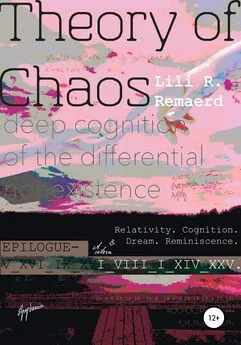Inna Borodina - Interdisciplinary theory of commercial communication. First part
- Название:Interdisciplinary theory of commercial communication. First part
- Автор:
- Жанр:
- Издательство:неизвестно
- Год:2022
- ISBN:978-5-532-95637-7
- Рейтинг:
- Избранное:Добавить в избранное
-
Отзывы:
-
Ваша оценка:
Inna Borodina - Interdisciplinary theory of commercial communication. First part краткое содержание
Interdisciplinary theory of commercial communication. First part - читать онлайн бесплатно ознакомительный отрывок
Интервал:
Закладка:
Relationships in the communication process reflect supply and demand: R1, R2 – the impact of the organization's objective on the behavior of employees (organizational competencies); r1 – product price offer and business reputation offer; r2 – is the price demand for the product and the demand for a positive business reputation; r3 – offering the individual and professional competencies of the Company's employees; r4 – offering individual and professional competencies of the "Customer"; r5 – demand for individual and professional competencies of the Company's employees and business reputation. The presence of the r5 connection is a special case of the manifestation of the effect of asymmetric information, and two-fold, and the system under study can be classified as open, with the property of self-organization. The characteristics of the environment are formed by the market awareness of counterparties through various media (branding and other components of marketing communications).
Studying the nature of consumer expectations in the process of concluding a contract, one should pay attention to two main characteristics of the "Customer" that form mutually intersecting sets of consumer expectations. Let's call these sets "individuals" and "corporations", indicating the boundaries of their interaction6.
"Individuals" implement the behavior of an individual consumer seeking to satisfy personal needs. They are guided by such motivational factors that are focused on their own reference group, trying to somehow justify its role expectations, to meet certain social standards. This focus on mass character is realized not only at the conscious level, but also manifests itself on the unconscious, which is monitored by the example of imitative behavior.
This type of behavior is formed through mass communications, while the informational impact is interpreted as a process of intangible production of the value of the goods. In this situation, the “private person” assesses the social component of the brand and business reputation of the partner through interaction at the level of individual and professional competence of employees. Consumer choice in favor of a particular counterparty by a “private person” can be divided into two phases: an effective choice, carried out in the same way by all consumers, and a personal choice of each consumer. In other words, consumer choice is a kind of social need that consists of a set of specific requirements determined by the individual's motivation. When the representatives of the "Customer" implement the model of the individual consumer, the behavioral characteristics fit into the pattern of relationships in the B2C (Business-to-Customers) market.
As David Myers notes, from the perspective of social psychology, all participants in social interaction are subject to prejudice, negative stereotypes and conformism. At the same time, certain behavioral models (“frustration and aggression, the need for status, distinctive features”6) that produce competition ultimately give rise to prejudices. The behavioral model of “attribution error”6 is also interesting, when in the process of interaction, individuals project onto the situation the characteristics of the personality and its status. In fact, objective procedural components are being replaced by personal socio-psychological preferences.
Thus, the "Individual" takes an active part in the search for satisfaction, that is, consumer utility is a finite set. Let's call it "private satisfaction", consisting of several levels of consumer satisfaction.
This is consistent with the conclusions of A.N.Leontyev that any activity based on the initial afferentation excites effector processes that implement contacts with the object environment, and then the image of the object is corrected and enriched with the help of feedbacks of the original afferenting image.
In neurobiology, the concept of reverse afferentation proposed by P.K.Anokhin, is used in the framework of the theory of functional systems.
Reverse afferentation can be divided into three types: 1) from the receptors that register the final result; 2) from the receptors of the executive organs; 3) based on the results of behavioral activity9.
The consumer expectations of a "corporation" are based primarily on the rational (professional) side of consumer choice. By "rational satisfaction" we mean the needs and requirements formed by the specifics of the industry market and the resources of the organization. Moving on to the resource approach, we note that each organization has certain sets of resources that form the results of their activities6. The "Company", acting as a seller of services, determines those levels of the "Customer" needs that he can satisfy. In this context, levels of "rational satisfaction" are also a criterion for selecting counterparties based on financial characteristics.
Considering “rational satisfaction”, it is interesting to refer to the work of Habermas J. Moral consciousness and communicative action, and in its context, the analysis of communication in the process of a transaction, as a discourse of economic agents, highlighting the following components: egocentric benefits, consent, mutual understanding, the desire of actors in mutual understanding10. These components of the discourse are associated with the traditions supported by the participants in communication, the degree of objectivity within the existing society. At the same time, communication takes place within the framework of social and economic institutions that have developed in society, which rely on existing norms (truth, correctness and truthfulness) and institutional mechanisms that bring norms into action (objectivism, norm formation and expressiveness).
Thus, the “rational satisfaction” of the communication participants is directly related to the moral consciousness of the community, in this case, the “Corporation”, or corporate culture. The degree of predisposition of the corporation's employees to distorting publicly presented commercial information (information asymmetry) and the level of market confidence in the “Corporation” (reputation).
In conclusion, I note that the consumer choice of a buyer in favor of a certain seller implements three phases: an effective choice made in the same way by all consumers, a personal choice of a decision-maker, and a rational choice determined by the organization's resources.
Competitive advantage today depends on the ability to satisfy not only the functional requirements of customers, but also their intangible needs in the form of prestige, convenience and reliability. This statement reflects the need for an interdisciplinary study of factors influencing consumer behavior, and the applied implementation of research results in the context of modern realities.
Effective approaches to advertising organization result in significant competitive advantage. Let's analyze the main directions of research in the field of assessing the effect of advertising. For a quantitative assessment of the phenomena under study, it is necessary to study the functional connections that arise in socio-economic systems, and to determine convenient ways of setting tasks. The study of generally accepted instrumental methods identified the following approaches to targets setting in the study of commercial communication: axiomatic approach; setting targets, optimization tasks; study of localized events not counting the influence of time; studies of the nature of the change in the phenomenon over time.
Such a grouping is conditional, since the indicated methods of analysis, to one degree or another, involved in the study of such a complex phenomenon as commercial communications are very diverse. The process of society's consumption of commercial information is associated with high entropy.
Therefore, the setting of tasks for assessing the impact of advertising, as a rule, is takes out on a localized subject and time scale. Localization is achieved by defining mainly qualitative, verbal search criteria, less often the designated criteria are formalized in the language of mathematics. For a clearer understanding of the problem, we will consider the basic concepts that allow us to study the influence of information on the behavior of individuals and communities united in groups based on various principles of a socio-economic nature.
The practical assessment of the advertising effect is based on popularized media planning technologies.
When making a purchase, the consumer motivates his aspirations by the desire to achieve the greatest satisfy (marginal utility) through the purchase of a product. Consumer preferences are usually described by the utility function U(x) defined on the set of sets of goods to achieve maximum satisfy (marginal utility). The consumer's choice is obviously determined by his desire to maximize the utility function.
The buyer is not searching for a product, but a solution to the problem that the product can provide. Different products can satisfy the same need. The individual consumer seeks to satisfy the need, guided by the main motivational factors and takes an active part in the search for compensation, that is, consumer utility is a function depending on the set of levels of consumer satisfaction U = [U1, U2, .. Un] where Ui – are the levels of consumer satisfaction. The behavior of the buyer as an economic agent that independently creates final satisfaction when combining time and goods was considered in the theories of Becker2 and Lancaster. Satisfaction levels are formed under the influence of many factors that can be described by a tuple (final sequence) Ui = always including three subsets that determine the consumer behavior of an individual, where Y – is a consumer good (product), H – are situational factors (advertising, advice of friends, weather, social networks, etc.), t – personal time.
With a conditionally fixed price for a product, there is a possibility of considering consumer behavior with a constant income, as well as with a change in income for the analyzed period. The social system of preferences is constantly changing over time under the influence of various informational stimuli – marketing, politics, etc.
Consumer behavior includes all types of human mental activity that precede, accompany and follow the decision to purchase. Customer behavior can be viewed as a decision-making process that can be divided into several stages, characterized equally by both the neurological reactions of a person and the psychological characteristics of human thinking. Let's designate the generalized stages of decision making by the buyer: awareness of the problem; assessment of alternatives; buying decision.
Possible economic situations in which an individual (potential buyer) may be, we denote as a finite set E={E1, E2 …, En} , where Ei – is a subset consisting of sets of two elements Ei={P, I} , including a set of prices ( P ) and disposable income (I) , while all possible options for consumer purchases can be described by the “budget restriction” condition.
The buyer's preferences at the time of selection are based on the level of perceived satisfaction from using the product. The general level of utility of the product to the customer depends on this satisfaction.
Let us define the market as a sphere of commodity-money relations, with an indirect relationship in the form of the sale and purchase of benefits, between producers and consumers of products, which combines means, methods, tools, organizational and legal norms. The structure of connections in the market in the market ensures the successful functioning of such relations.
Читать дальшеИнтервал:
Закладка:









